#b des interior design
Explore tagged Tumblr posts
Text

#top interior designing colleges in india#interior design courses in bangalore#interior design courses#interior course in bangalore#bachelor of interior design#b des interior design#b interior design bangalore
0 notes
Text

B Des Interior Design - B Des Interior Design is among 4 year Bachelor of Interior Designing Courses offered at ARCH College, Jaipur which trains the interior design aspirants as per the industry standards. Check out the B Des Interior Design complete details like syllabus, course duration, career opportunities, and other details at https://www.archedu.org/b-des-interior-design.html
0 notes
Text
B Des Interior Design Universities in India | AAFT University
Explore AAFT University, one of the top BDes Interior Design universities in India. Get hands-on training, industry exposure, and expert mentorship. With a curriculum that blends creativity and practical skills, AAFT University prepares students for real-world challenges. Apply now and shape your future in Interior design!

0 notes
Text
Woxsen University is a premier institution known for its cutting-edge programs and world-class facilities. Among its standout courses is the B.Des in Interior Designing, designed to nurture creativity and innovation in students. This program blends design theory with practical applications, preparing students to excel in the competitive interior design industry. With expert faculty, state-of-the-art infrastructure, and an industry-focused curriculum, Woxsen ensures a holistic learning experience. Pursuing a B.Des in Interior Designing here equips students with the skills and knowledge to create impactful, functional, and aesthetic spaces.

0 notes
Text
Interior Designing Courses After 12th | Bdes in Interior- NIFD Pune

NIFD Global Pune Kothrud is one of the Best B.des Colleges in Pune and offers Interior Designing courses after 12th. Study 3 Years undergraduate Interior design program has been updated with a new syllabus & placements
0 notes
Text
Your Guide to B.Des & B.Arch Courses in Kerala: Top Colleges, Admission Procedures, and Program Details
DC School offers a comprehensive guide to pursuing Bachelor of Design (B.Des) and Bachelor of Architecture (B.Arch) programs in Kerala. Whether you're interested in a B.Des course in Vagamon, Trivandrum, or across Kerala, or exploring B.Arch colleges and admission procedures, our platform provides in-depth information to help you make informed decisions.
Bachelor of Design (B.Des) Programs: DC School highlights premier B.Des courses available throughout Kerala. Our guide includes:
B.Des Interior Design Colleges: Find top institutions offering specialized interior design programs. Learn about the curriculum, faculty, and facilities that make these colleges stand out.
Bachelor of Design in Kerala: Explore a list of the best B.Des colleges across Kerala. We cover institutions offering various specializations, including product design, graphic design, and fashion designing.
Top B.Des Colleges in Trivandrum: Discover leading colleges in Trivandrum that offer exceptional B.Des programs. Our guide provides details on their courses, campus life, and admission requirements.
Bachelor of Design Specializations: Whether you’re interested in fashion designing, product design, or graphic design, our guide details the top B.Des colleges in Kerala for each specialization.
Bachelor of Architecture (B.Arch) Programs: Our detailed guide covers B.Arch programs across Kerala, including:
B.Arch Admission Procedures: Get step-by-step information on the admission process for B.Arch courses. We cover entrance exams, eligibility criteria, and the documentation required for a successful application.
Best B.Arch Colleges in Kerala: Learn about the premier B.Arch institutions in Kerala known for their excellent education, state-of-the-art facilities, and industry connections.
Top 10 B.Arch Colleges: Our curated list features the top 10 B.Arch colleges in Kerala, providing insights into their strengths, programs, and unique offerings.
B.Arch Admission in Kerala: Understand the specific admission procedures for B.Arch programs, including application timelines and selection criteria.
Other Relevant Design Programs: In addition to B.Des and B.Arch, DC School provides information on other relevant design programs:
Bachelor of Arts in Graphic Design: Explore colleges offering a Bachelor’s degree in graphic design. Our guide highlights programs that focus on digital and visual communication skills.
Bachelor’s Degree in Fashion Designing: Discover institutions that offer degrees in fashion designing, including details on course content, industry exposure, and career prospects.
Bachelor of Design in Product Design: Learn about B.Des programs with a focus on product design, covering curriculum, career opportunities, and top colleges offering this specialization.
Why DC School? DC School is dedicated to providing comprehensive and reliable information about design and architecture education. Our guides are crafted to help prospective students navigate their options and make informed decisions about their educational journey. With detailed insights into course offerings, college rankings, and admission processes, we ensure that you have the tools you need to succeed.
Get Started with DC School: Ready to embark on your educational journey in design or architecture? Visit DC School for a complete overview of B.Des and B.Arch courses, including top colleges and admission procedures. Our platform is here to support you in making the best choice for your academic and career goals. Explore your options today and take the first step towards a successful future in design or architecture.
#b.des course in vagamon#b.des trivandrum#b.des colleges in trivandrum#b design course in kerala#b des course in kerala#b des colleges in kerala#Bachelor of Design colleges in Kerala#b des interior design colleges in kerala#Best B Arch & B Des College in Kerala#b arch admission procedure in kerala#b arch admission in kerala#b arch course colleges in kerala#b arch colleges in kerala#b architecture colleges in kerala#b design admission#best b arch colleges in kerala#top b.des colleges in kerala#b des course#top 10 b arch colleges in kerala#Interior Design Colleges in Kerala#bachelor of design in product design#bachelor of arts degree in graphic design#bachelor's degree in fashion designing
0 notes
Text
From Concept to Creation: Inside Woxsen University's B.Des Curriculum

Woxsen University, located in Hyderabad, India, is renowned for its innovative and comprehensive design programs. The university is dedicated to nurturing creative minds and preparing them for successful careers in various design fields. Among its diverse offerings, Woxsen University’s Bachelor of Design (B.Des) programs stand out for their emphasis on practical skills, industry engagement, and cutting-edge design education. This article delves into the specifics of the B.Des programs at Woxsen, including B.Des in Interior Designing, B.Des Industrial Design, and the details about the B Des course fees.
Why Choose Woxsen University for B.Des Programs?
Woxsen University’s School of Arts and Design offers a range of B.Des programs aimed at fostering creativity and technical proficiency. The curriculum is designed to provide a balanced mix of theoretical knowledge and practical application, ensuring that students are well-equipped to meet the demands of the design industry.
Key Features:
State-of-the-art infrastructure and design studios.
Experienced faculty with extensive industry backgrounds.
Industry partnerships and real-world project opportunities.
Comprehensive curriculum covering the latest trends and technologies in design.
Focus on interdisciplinary learning and innovation.
B.Des in Interior Designing
The B.Des in Interior Designing program at Woxsen University is tailored to equip students with the skills required to create functional and aesthetically pleasing interior spaces. This program emphasizes a holistic approach to design, considering both the artistic and technical aspects of interior spaces.
Course Highlights:
In-depth study of space planning, color theory, and materials.
Training in the use of design software like AutoCAD, SketchUp, and Revit.
Emphasis on sustainable and environmentally friendly design practices.
Exposure to real-world projects and internships with leading design firms.
Workshops and seminars by industry experts to keep students updated with current trends.
Career Opportunities:
Graduates of the B.Des in Interior Designing program can pursue careers as interior designers, space planners, design consultants, and more. The program also prepares students for roles in specialized fields such as residential, commercial, and industrial design.
B.Des Industrial Design
The B.Des Industrial Design program at Woxsen University focuses on the design and development of products that are both functional and aesthetically pleasing. This program is designed to foster innovation and creativity, encouraging students to think outside the box and develop unique product solutions.
Course Highlights:
Comprehensive training in product design, ergonomics, and user experience.
Hands-on projects that involve creating prototypes and working with different materials.
Access to advanced tools and technologies such as 3D printing and CAD software.
Interdisciplinary approach integrating engineering, art, and business concepts.
Opportunities to collaborate with industry partners on real-world design challenges.
Career Opportunities:
Graduates of the B.Des Industrial Design program can work as product designers, UX/UI designers, industrial engineers, and innovation consultants. The skills acquired in this program also open doors to careers in various sectors such as consumer electronics, automotive design, and furniture design.
Understanding the B Des Course Fees at Woxsen University
When considering a design program, understanding the B Des course fees is crucial for prospective students. Woxsen University provides a detailed fee structure to ensure transparency and help students plan their finances effectively.
Fee Structure:
Tuition fees cover academic instruction, access to design studios, and use of university facilities.
Additional costs may include materials, software licenses, and participation in workshops or seminars.
Scholarships and financial aid options are available to eligible students based on merit and need.
Detailed breakdowns of fees for each semester can be accessed through the university’s official website.
Value for Money:
Investing in a B.Des program at Woxsen University offers significant returns through quality education, extensive industry exposure, and a robust support system for career development. The university’s focus on practical skills and real-world applications ensures that graduates are well-prepared for the competitive job market.
Conclusion
Woxsen University stands out as a premier institution for design education in India, offering specialized programs such as the B.Des in Interior Designing and B.Des Industrial Design. With a strong emphasis on practical skills, industry engagement, and innovation, Woxsen provides an ideal environment for aspiring designers to flourish. Understanding the B Des course fees and the value offered by Woxsen University further underscores the institution’s commitment to delivering top-notch design education. For those looking to make a mark in the design world, Woxsen University offers the tools, resources, and opportunities needed to succeed.
0 notes
Text
How to Excel in B Des Fashion and Interior Design Courses

The Bachelor of Design (B Des) in Fashion and Interior Design are two of the most sought-after courses for creative minds aiming to make a mark in the design industry. Excelling in these courses demands creativity, passion, and a strategic approach toward learning and practical application. Here’s how you can excel in B Des in Fashion Designing and B Des in Interior Designing, shaping a successful career in design.
Understand the Basics
The first step to excelling in any course is to build a strong foundation. Understanding the basics of design principles, history, materials, and techniques is crucial for fashion and interior design courses. Dive deep into the fundamental concepts and always stay curious to learn more. The basics will serve as your guide in every design challenge you face.
Practice Relentlessly
Design is a skill honed by practice. Regularly working on your drawing, sketching, and designing skills is essential. Whether it's fashion or interior design, the more you practice, the better you become. Experiment with different styles, materials, and techniques. This improves your skill set and helps you find your unique design voice.
Stay Updated with Trends
The design world is ever-evolving. Staying updated with the latest trends in fashion and interior design is important. However, it's also crucial to understand the history and evolution of design to predict future trends. Use online resources, magazines, and books to keep yourself informed. Attend workshops, exhibitions, and seminars whenever possible.
Leverage Technology
In this digital age, proficiency in design software and tools is as important as your creative skills. Learn to use software like Adobe Photoshop, Illustrator, AutoCAD, and SketchUp. These tools help bring your designs to life and are essential for presenting your ideas professionally.
Build a Portfolio
Your portfolio is a reflection of your skills and creativity. Start building your portfolio from the beginning of your course. Include a variety of work showcasing your skills, creativity, and understanding of design principles. A strong portfolio is crucial when applying for internships or jobs.
Seek Real-world Experience
Internships and part-time jobs provide invaluable real-world experience. They offer a glimpse into the industry's workings and help build a professional network. Try to secure internships in reputable design firms or with established designers. The practical experience gained will be instrumental in your growth and success.
Collaborate and Network
Building a network within the design community is vital. Collaborate with peers on projects, participate in design competitions, and attend industry events. Networking helps you share ideas, learn from others, and open up opportunities for future collaborations and job prospects.
Reflect and Iterate
Design is an iterative process. Always be open to feedback and willing to make changes to your designs. Reflect on your work critically and learn from both successes and failures. Continuous improvement is key to mastering the art of design.
Swarrnim University: Shaping Future Designers
Swarrnim University, situated in the heart of Gandhinagar, offers comprehensive B Des courses in Fashion Designing and Interior Designing. With a focus on practical learning, the university provides state-of-the-art facilities, experienced faculty, and a curriculum that aligns with the industry’s current demands.
The interior design course in Gandhinagar at Swarrnim University is designed to equip students with creative skills and practical knowledge. Students are encouraged to experiment, innovate, and develop designs that are aesthetically pleasing but also functional and sustainable.
Similarly, the B Des in Fashion Designing course at Swarrnim University focuses on developing the students' understanding of fashion trends, materials, and the fashion industry's business aspects. The course aims to nurture creative minds who can contribute to the fashion industry with innovative designs.
At Swarrnim University, students have numerous opportunities to engage in real-world projects, internships, and workshops with industry professionals. This hands-on approach ensures that students are well-prepared to embark on their design careers upon graduation.
Conclusion
Excelling a B Des in Fashion Designing and a B Des in Interior Designing requires a mix of creativity, hard work, and strategic learning. By understanding the basics, practicing relentlessly, staying updated with trends, leveraging technology, building a strong portfolio, seeking real-world experience, collaborating, and continuously improving, you can set the foundation for a successful career in the design industry. Swarrnim University, with its comprehensive courses and industry-aligned curriculum, serves as an ideal platform for aspiring designers to realize their potential and craft their future in the design world.
#B Des in fashion designing#B Des in interior designing#Interior design course in Gandhinagar#swarrnim university Gujarat#ssiu gandhiangar
0 notes
Text
Moorcroft Pottery De Morgan Cornflower Mirror Nicola Slaney
#moorcroft #artsandcrafts #stratforduponavon

Moorcroft Pottery De Morgan Cornflower Mirror Nicola Slaney
#moorcroft #artsandcrafts #stratforduponavon
#moorcroft#moorcroft pottery#de morgan#cornflower#mirror#interior design#b and w thornton#23 henley street#stratford on avon#stratford upon avon#warwickshire#england
0 notes
Text

Discover your creative potential at one of the best colleges for interior design in Delhi. Explore IILM and start your journey towards success. Contact Now!
0 notes
Text
Colour Psychology: How Colors Influence Mood and Behavior in Interior Design
Interior design is about creating functional, aesthetically pleasing spaces catering to our physical and emotional needs. A key aspect of achieving this is through the use of colour, which profoundly impacts our mood, behaviour, and overall well-being. In this blog, we will explore the importance of colour psychology in interior design and how professionals can leverage it.

Relationship between Color Psychology & Interior Design
Colour psychology is a branch of psychology that studies how colours affect human behaviour and emotions. It is an essential aspect of interior design, as colour can influence how a space is perceived and experienced. As such, it is necessary for interior designers to have a deep understanding of colour psychology and how to apply it in their work.
The Science of Color
Colour is a visual sensation created when light enters the eye and is processed by the brain. Different colours have different wavelengths, which affect how the brain perceives them. For example, warm colours like red and orange have shorter wavelengths and are perceived as energising and stimulating. Cool colours like blue and green have longer wavelengths and are perceived as calming and relaxing.
The effect of Colors on Mood and Behavior
Colours have a powerful influence on our mood and behaviour. For example, red is associated with passion, energy, and excitement, while blue is associated with calmness, tranquillity, and relaxation. Understanding these associations can help interior designers create spaces that evoke the desired emotional response in their clients.
Importance of Color in Interior Design
Colour is an essential component of interior design, as it can transform a space and create a specific mood or atmosphere. It can be used to highlight architectural features, create focal points, and define the space's overall style.
Colours & colour scheme for Interior Design
When choosing colours for interior design, it is crucial to consider the function of the space, the desired mood or atmosphere, and the client's preferences. For example, a bedroom should have calming and soothing colours, while a home office may benefit from energising and stimulating colours. Colour schemes are combinations of colours that work well together and create a specific mood or atmosphere. Some common colour schemes include monochromatic, analogous, and complementary. Monochromatic colour schemes use variations of a single colour, while analogous colour schemes use colours adjacent to the colour wheel. Complementary colour schemes use opposite colours on the colour wheel, creating a high-contrast, dynamic effect.
The Effect of Color on Perception of Space
Colours can also affect the perception of space, making it appear larger or smaller. Lighter colours, such as white and pastels, create an illusion of space and airiness, while darker colours, such as navy and black, can make a space feel smaller and more intimate.
Leveraging Color Psychology in Interior Design & choosing the right colours
Interior designers can leverage colour psychology to create spaces that are not only aesthetically pleasing but also promote well-being and productivity. The choice of colour in interior design can make or break the ambience of a room. From evoking emotions to setting the tone of the space, every colour has a distinct role in interior design:
White: White is often associated with purity, simplicity, and cleanliness. It creates a sense of calm and peacefulness in a room, making a space feel larger and brighter. White walls are a popular choice in modern interior design and can be paired with various accent colours to create a specific mood or atmosphere.
Red: Red is a bold and energetic colour that can create a sense of passion and excitement in a room. It's often used as an accent colour in interior design to add warmth and depth to a space. Red is particularly effective in people's gathering areas, such as living or dining rooms. However, too much red can be overwhelming, so balancing it with other colours and using it sparingly is essential.
Blue: Blue is a calming and soothing colour that can create a sense of serenity in a room. Lighter shades of blue can make a space feel larger and more open, while darker tints can create a more intimate and cosy atmosphere. Blue is often used in bedrooms and bathrooms because of its calming effects. It's also a popular colour for coastal or beach-inspired interior design.
Green: Green is a versatile colour that can create a sense of balance and harmony in a room. It's often associated with nature and can create a calming and refreshing atmosphere. Lighter shades of green are perfect for bedrooms and living rooms, while darker tints can create a cosy and intimate atmosphere in dining rooms and kitchens. Green is also a popular colour for eco-friendly or sustainable interior design.
Yellow: Yellow is a cheerful and uplifting colour that can create a sense of happiness and positivity in a room. It's often used in kitchens and dining rooms to create a welcoming and inviting atmosphere. Yellow is also famous for children's rooms and plays areas because of its playful and whimsical nature. However, too much yellow can be overwhelming, so balancing it with other colours and using it sparingly is crucial.
Purple: Purple is a regal and luxurious colour that can create a sense of sophistication and elegance in a room. It's often used in bedrooms and bathrooms to create a calming and relaxing atmosphere. Lighter shades of purple, such as lavender, can create a romantic and feminine vibe, while darker shades, like plum, can create a more dramatic and bold atmosphere. Purple is also a popular colour for bohemian or eclectic interior design.
Orange: Orange is a warm and energetic colour that creates excitement and enthusiasm in a room. It's often used in living and family rooms to create a welcoming and lively atmosphere. Orange is also a popular colour for home offices and workspaces because of its ability to stimulate creativity and productivity. However, too much orange can be overwhelming, so balancing it with other colours and using it sparingly is essential.
Black: Black is a powerful and dramatic colour that can create a sense of sophistication and elegance in a room. It's often used in modern and minimalist interior design to create an elegant and stylish atmosphere. Black can also be used as an accent colour to create contrast and depth in a room. However, too much black can make a space feel dark and oppressive, so it's crucial to balance it with lighter colors and use it sparingly.
Grey: Gray is a neutral and versatile colour that can create a sense of balance and sophistication in a room. It's often used as a base colour in interior design and can be paired with various accent colours to create a specific mood or atmosphere. Lighter shades of grey can create a calming and peaceful atmosphere, while darker tints can create a more dramatic and moody atmosphere.
By understanding the emotional and behavioural associations of different colours, they can use colour to create specific moods or atmospheres and enhance the functionality of a space.
Summing it up
In conclusion, colour psychology is an essential aspect of interior design and can significantly influence the mood, behaviour, and overall well-being of those who inhabit a space. By understanding the science of colour and leveraging colour schemes, interior designers can create functional, aesthetically pleasing spaces that cater to the needs of their clients.
0 notes
Text
Inspiring Interior Innovations: Bachelor of Design - Interior Design Curriculum Breakdown
Interior design is an exciting and dynamic field that combines creativity, technical skills, and a deep understanding of human needs to create functional and aesthetically pleasing spaces. Alliance University offers a comprehensive Bachelor of Design in Interior Design program that stands out among the top interior design colleges in Bangalore.

Why Choose Alliance University for Interior Design?
Alliance University is renowned for its robust curriculum and industry-oriented approach, making it one of the best universities for interior design. The program is designed to equip students with the knowledge and skills needed to excel in the competitive world of interior design.
Curriculum Overview
The Bachelor of Design in Interior Design program at Alliance University covers a wide range of topics essential for becoming a successful interior designer. Here’s a detailed breakdown of the curriculum:
Foundation Year
- Design Fundamentals: Introduction to basic design principles, color theory, and spatial arrangement.
- Drawing and Visualization: Developing drawing skills and visual thinking necessary for design communication.
- History of Interior Design: Understanding the evolution of interior design through different historical periods.
Intermediate Years
- Space Planning and Management: Techniques for efficient use of space in residential and commercial settings.
- Sustainable Design Practices: Emphasis on eco-friendly design solutions and materials.
- Interior Lighting and Acoustics: Study of lighting and sound to create comfortable and functional environments.
- Materials and Finishes: Exploration of different materials and finishes used in interior design projects.
Advanced Years
- Advanced Interior Design Studio: Hands-on projects and design challenges to apply theoretical knowledge.
- Professional Practice: Understanding the business side of interior design, including project management and client relations.
- Internship: Gaining real-world experience through internships with top design firms.
Practical Learning
Alliance University ensures that students get ample hands-on experience through projects, workshops, and internships. This practical approach helps students apply their learning in real-world scenarios, making them industry-ready upon graduation.
Studying in Bangalore
Bangalore is a thriving city known for its vibrant culture and booming tech industry. It is also home to some of the top interior design colleges in Bangalore. Studying at Alliance University provides students with the opportunity to immerse themselves in a dynamic urban environment with numerous opportunities for networking and professional growth.
Fees and Duration
The interior designer course duration at Alliance University is typically four years. Detailed information about interior design course fees in Bangalore and interior design courses university can be obtained directly from the university's admissions office.
Career Prospects
Graduates of the B Des Interior Design program from Alliance University are well-prepared to enter the professional world of interior design. Career opportunities include roles such as:
- Interior Designer
- Space Planner
- Design Consultant
- Interior Decorator
The university's strong placement support ensures that students have access to excellent job opportunities in top design firms and companies.
Conclusion
Choosing to pursue a Bachelor of Design in Interior Design at Alliance University is a significant step towards a successful career in interior design. With its comprehensive curriculum, hands-on training, and prime location, Alliance University stands out as one of the best interior design colleges in Bangalore. Enroll today and start your journey towards becoming an innovative and successful interior designer. Experience the best interior design courses at Alliance University, where creativity and practicality merge to foster your growth as a future design professional.
#b des interior design colleges#interior design courses in bangalore#interior design courses#interior course in bangalore#interior decoration course in bangalore#interior designing in bangalore#Bachelor of Interior Design#best interior design colleges in bangalore#colleges for interior design in bangalore#interior design courses university
0 notes
Text
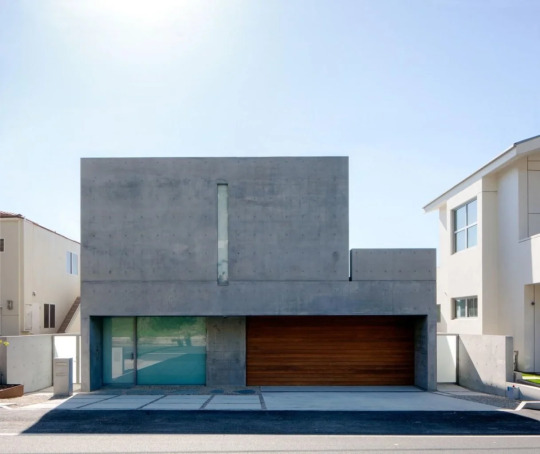
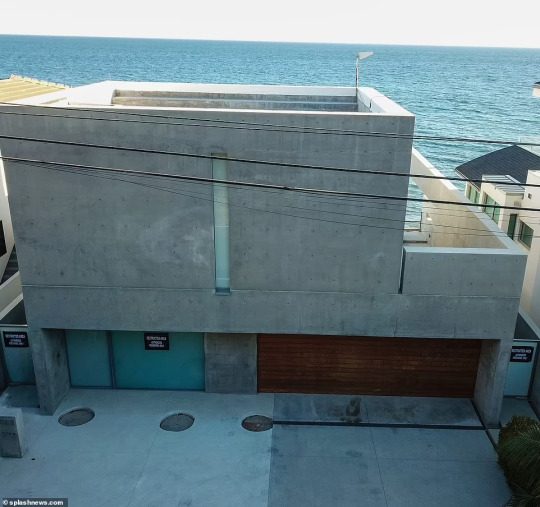
Kanye West, legally known as Ye, is selling the Malibu, California home he ruined, for $53M (He bought it for $57M). The house was designed by one of the world’s most eminent architects, Tadao Ando, and Ye stripped it clean of windows, doors, electrical, and many of the architect’s signature interior finishes.
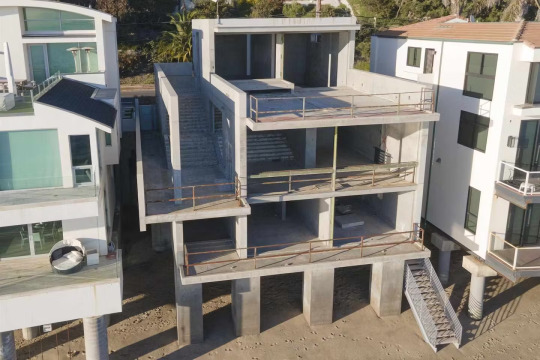
Sitting since 2021, the mansion is now rotting. Wait. This is $53M for a cement shell, basically. The brutalist style home has 1,200 tons of poured concrete and 200 tons of steel reinforcement to hold it all together with 12- 60 ft. pylons sunk into the sand.
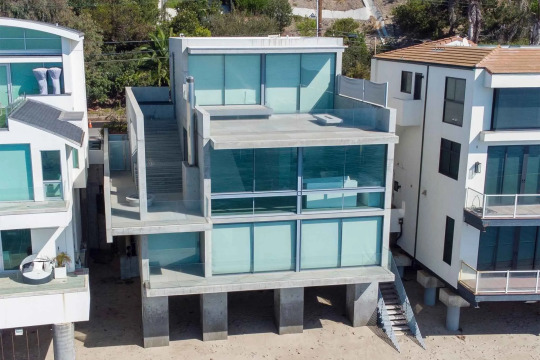
The beachside house was once the epitome of artistic ingenuity.

The floor-to-ceiling windows facing the water have long been removed, leaving the rear of the building entirely open to the elements.
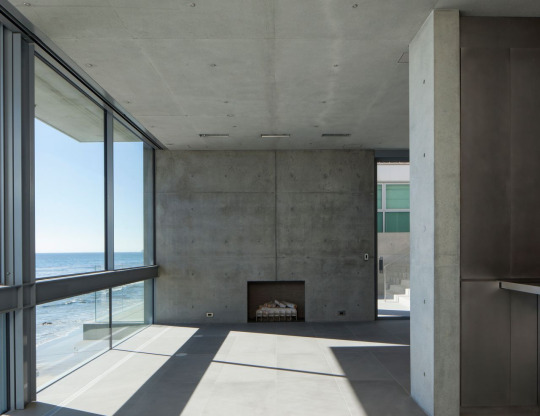
All of the interior photos are before it was gutted. The alleged plan was to try to turn the mansion into a “Bat Cave” so he could “hide from the Clintons and Kardashians.”

Ye’s new celebrity realtor believes the renovations are a selling point b/c he left a blank canvas, making it easier for the new owners to design the home exactly to their liking.

The house needs windows and doors, along with plumbing, electrical, HVAC and interior finishes, b/c they've all been removed.
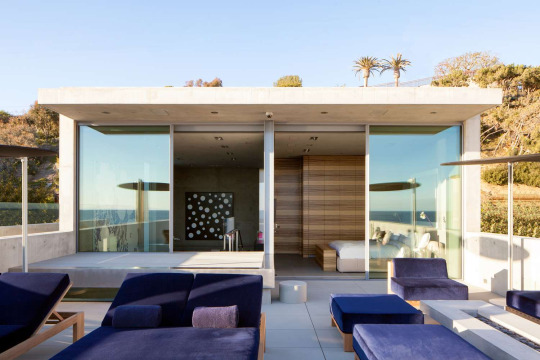
Although Ye removed the interior finishes, “this creates an unbelievably rare opportunity to buy a Picasso on the water," said the agent.

“This architect is known for his concrete work, which is what remains,” he says, "It was a very minimalist interior previously and will likely continue to be that in order to allow the architecture to speak louder than the finishes.”
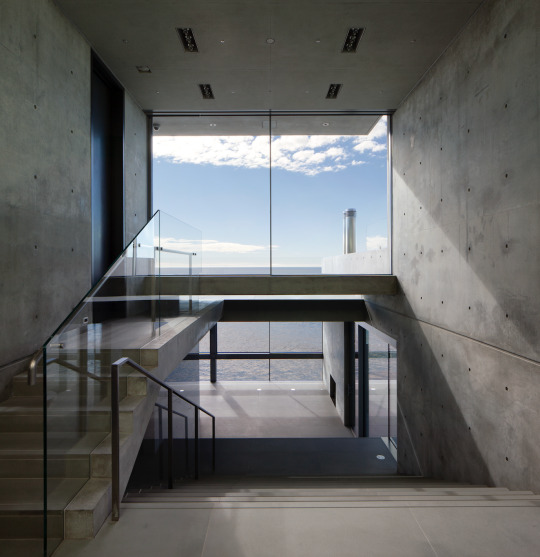
The plan was to go off grid. The contractor said, “Ye wanted no electricity. He only wanted plants, candles, battery lights; and to have everything open and dark. You can’t keep food in that house, because you had no refrigerator left. You had no windows. I had seagulls flying in.”

The former architectural tour de force was only one of the few private homes in the United States designed by the renowned Pritzker Prize-winning Japanese architect. Best known for his minimalist structures and “smooth-as-silk” concrete.

The upper-level terrace pictured here comes out from a main bedroom suite that takes up the entire top floor.
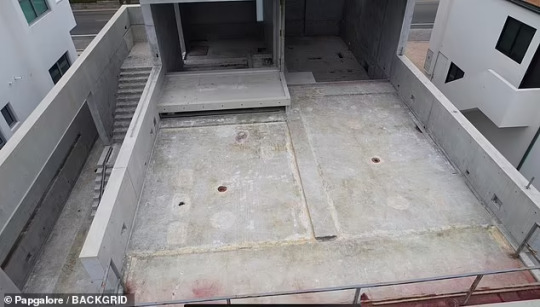
I don't know what to think. Everything is gone- no utilities, none of the original elements the architect is known for, not even any windows. And, he's only knocked off $4M from what he paid for it, complete.

It's rotting from the inside out. Here's a collapsed concrete wall and rusted railings. On top of all of this, it's unsafe b/c concrete is falling. It's like a total knockdown.
225 notes
·
View notes
Text
RICKMAS 2024 - DAY 15 - DECORATIVE OBSESSION

Pairing : Sinclair Bryant x OC (Anna)
Summary : When Sinclair get involved in a Christmas contest, he becomes a little bit too enthusiastic about it.
Tag(s)/Warning(s) : Mention of incest.
Also read on AO3 - Wattpad


Sinclair didn't know what had gone through his head when he'd agreed to enter this stupid Christmas decorating contest.
It had been Dame Aurora De Longrantfirth's idea to liven up the posh neighbourhood they lived in. Sinclair had always loved Christmas, but he'd always been far too busy with his work to enter such contests, but the old woman had insisted, saying he was the sleaziest neighbour on the street, and Sinclair's pride had been stung.
Except that he'd quickly gotten a taste for it, so much so that he'd decided to beat his neighbour Andrew, an annoying lawyer who fancied himself a poet in his spare time. Sinclair's plan was simple: Andrew would recreate the North Pole, create a Christmas at Versailles for him. Grand chandeliers, gilded mirrors, swans carved from ice, nothing would be too beautiful to decorate his estate.
Except that it made him a little... hysterical. The assistant he had hired couldn't take it anymore. Nothing was too good, too extravagant for Sinclair who applied the principle that money was made to spend.
Except that he didn't really know what he wanted and made the poor man run around in all directions, assembling, disassembling, reassembling decorations all day long.
"What do you mean, you're resigning ?" Sinclair asked, his face defeated.
"Mr Bryant, you are an intelligent man, I am sure you know the definition of the word resign. I am leaving ! I want nothing more to do with Christmas decorations. Besides, I call off Christmas at my house for this year !
This had come about after an argument about the colour of the curtains. He had been going around in circles for part of the afternoon before calling Peter, a work colleague who was as useless as he was with both decoration and electronics, but he had the advantage of having a wife who was up to date and interested in interior design.
She immediately advised him to take a look at a small vintage shop in central London. The owner had very good taste according to her since she had helped him redecorate the living room.
Although he was not convinced by the idea of entrusting the decorations of his house to a vintage clothing seller who seemed to have no real qualifications as a decorator, he went to see her.
"Can I help you?" she asked as she watched him pace around his small shop.
The place wasn’t very big, but it was bright, everything seemed to be in its right place and the walls had been tastefully painted.
“Are you the owner ?” Sinclair asked as he turned to her.
“Yes. Well, the tenant, but everything in the store is mine. Can I help you ?” she asked again with a warm smile.
Sinclair swallowed hard. It had been a long time since a woman had smiled at him like that, without even knowing who he was and what he had to offer.
“Carla Davis said you could help me,” he began hesitantly.
The young woman’s eyes lit up at the name Carla.
“Oh, she’s a regular customer. What can I do for you ?”
Sinclair told her what he had in mind in a few words, but she seemed to have understood what he wanted.
"Come back tomorrow, I'll show you some sketches."
"Very well, thank you, miss..."
"Anna, Anna Morton," she said, still smiling broadly, revealing two crooked front teeth.
"Sinclair, Sinclair Bryant, nice to meet you," he said, holding out his hand.
She shook it without hesitation. Her hand was small and cold compared to Sinclair's, but the electric shock he felt when he grabbed it had stunned him. He hadn't felt that way since... ever, actually.
When he returned to the store the next day, the sketches were ready as promised.
"It's... minimalist," he said cautiously.
"We can modify it, of course. It would be easier if I could see your house."
"Well, let's do it."
"Now ?"
"Oh, sure ! The store. I'll be back at closing time and take you ?"
Anna hesitated. She didn't know anything about this Sinclair after all and she'd read enough detective novels to know that it was a bad idea to get into a car with a stranger. On the other hand, he was sent by Carla and while they weren't exactly friends, she trusted her enough to believe that she wouldn't send him a raving lunatic for a customer.
"Well, be back in three hours."
With a clock like a Swiss cuckoo, Sinclair was there for closing time. He bundled her into his car and drove through the traffic and rain to his estate.
"It's a bit much for one person all by himself," Sinclair said, a little embarrassed by Anna's silence as she stared at the mansion.
"If you're comfortable there, that's enough, right ?"
"Exactly," Sinclair enthused, "according to studies, feeling at home is to have it all with our ability to create intimate spaces where we feel good and where we can build ourselves, nothing else," he added with a smile.
"And you have that here ?" the young woman asked sincerely.
Sinclair's smile faded slightly. He had that. Before. Before the divorce.
Understanding that she had perhaps touched a sensitive chord, Anna preferred to change the subject by asking him if he intended to let her in or if he was just waiting for her to lose her toes.
"Oh, of course, the temperatures are negative. They're predicting frost for tonight," he said as he opened the door for her.
He showed her the different areas to decorate while mentioning the dangers of global warming, but Anna interrupted him with a blunt and frank remark that disconcerted Sinclair.
"It looks like your living room swallowed a jewellery store..."
"What ?! These gilts are exceptional pieces," he said, slightly offended.
"Everything screams opulence, exceptionality, grandiose. You are most certainly doing the same thing as your neighbour: a display of your money. Nothing screams welcome and warmth, however."
Sinclair was speechless. If only he had known that this was only the beginning.
Throughout the two weeks, the arguments between him and Anna were constant.
"You are supposed to help me, not annoy me," he said one afternoon when she refused to take his advice about a Rococo vase that he thought was lovely but she considered abominable.
"I listen to you, I never stop listening to you. But instead of giving me decorating advice, keep explaining to me why green paint killed our ancestors and why your great-great-great-great grandmother had yellow skin. I didn't quite get the whole powder compact thing."
She frustrated him, but she also intrigued him. She listened to him when he talked about something other than decorating, most of the time with interest. She even asked pertinent questions when he was used to people ignoring him.
"Why didn't you study art ? Or decorating ? Or even fashion ?" Sinclair suddenly asked.
"I had been accepted to the Royal College of Art. But at the time, my mother fell ill and my father was about to lose his job due to staff restructuring. He wasn't sure he'd find a job again given his age, so I gave it up."
"That's a shame," Sinclair murmured.
"That's the truth. Sometimes you have to put your dreams aside."
She said it without sounding bitter, but Sinclair was sure she was hiding her feelings deep down.
"You never thought about going back to school ?"
"I'm too old for that now."
"Nonsense ! It's never too late to start over or even begin. Besides, statistically, it's between the ages of 30 and 40 that many women start studying at university and some even decide to start over to retrain."
She smiled, a sweet smile that made Sinclair melt.
"That's nice Sinclair, but... you need money to study and I have my store. I know I could work and study at the same time, but honestly, I don't know if I'd have the courage."
He nodded. He could understand. Not everyone had a background like his, parents who were financially secure enough to be able to afford to try, fail, or even not give 100%, even if that had never been the case for him. Sinclair had always been a brilliant student, aware of how lucky he was to be able to study.
"Sinclair, what do you want to do with this chandelier?" Anna asked, seeing the gigantic crystal chandelier that proudly sat on the floor of the veranda.
"Put it on the ceiling of the living room of course."
"It's going to be too heavy."
"The salesman assured me it would be perfect."
"And I'm telling you it's going to be too heavy. We've already created a swampy atmosphere with your fountain idea that overflowed and flooded your floor, let's try not to destroy the ceiling."
"It'll hold, I tell you."
The next day, Sinclair and the workers who had installed the chandelier were forced to admit that she was right. When Anna had arrived that morning, the four men were staring at the ceiling with a stupid look.
"You cracked your ceiling, Sinclair," she remarked.
"I saw it, thank you," he grumbled.
"Get someone to come right away so that the crack doesn't get worse and to make sure there's no danger. The only thing missing is the sky falling on our heads."
Seeing how affected he seemed, you had agreed to have dinner with him. The meal had been simple, topped off with a dessert that Sinclair and you devoured down to the last crumb.
"I've always dreamed of greatness. My parents, especially my mother, always said that's what defined us," he confided, pouring himself a glass of whiskey.
"Defining yourself by which meaning ?" Anna asked, sipping her tea.
"No idea. It sounds snobby when you say it like that, but I promise you that my mother is one of the kindest and most respectful women I know. She grew up poor. She didn't know money and luxury until she married my father. I think that's why she always did too much and she passed that little flaw on to me."
Anna placed her hand on his with an indulgent smile. Sinclair's vulnerability had taken her by surprise, but she liked this new side of him, less sure of himself.
"You don't need to impress anyone, Sinclair. You're a good, cultured, kind person. Show it with simplicity."
He watched her, surprised by what she had just said, but also strangely relieved. He turned his hand so that he could close it on Anna's, his thumb caressing the back of her hand.
"It's just a competition, Sinclair," she added softly.
"You're right," he said, "but that's how I am, I always put too much heart into everything I undertake."
"It's a quality."
At least that's what she had thought until the day before the competition. Everything was perfect, the house was sumptuous, but an argument had come to tarnish all that. He had said unfortunate words that he now regretted having said, but it was too late. He had, without meaning to, insulted her and her talent by reducing it to a lack of diploma. As if pieces of paper told everything about the value and abilities of a no one.
"You don't need me anymore, Sinclair," Anna whispered, disappointed and hurt, "good luck with the contest," she added before leaving.
He had treated her like just another assistant, someone of no importance, and he felt so bad about it. He couldn't erase from his memory the hurt look in Anna's eyes, the tears she had held back.
All night, he had lain awake staring at the house. And now, a few hours before the contest began, he wasn't so sure he wanted to enter. Every detail, down to the tiniest sprig of mistletoe, reminded him of Anna. She had, in just two weeks, given him so much more than creative ideas. She had crept into him, slowly but surely and now, and he wanted to know if she could be more than the little vintage clothes saleswoman from Islington. Yes, maybe she could be a little saleswoman, but also his.
"What does winning matter if she's not there to celebrate with you Bryant ?!"
Without waiting, he grabbed his car keys and drove away, leaving all the lights out behind him. Without her, there was no joy, no warmth, neither in the house nor in him.
Except he had no idea where she lived or when that Christmas Eve the store was closed.
"Damn, Sinclair, what an idiot !"
"I couldn't have said it better myself," a voice said behind him.
He turned around with a start. There she was, behind him. He had to pinch himself just to make sure it wasn't a mirage created by his mind.
"What are you doing here ?" they asked in unison.
"I forgot my mother's Christmas present," Anna said with a small laugh, "and you ?"
"I...I wanted to see you."
"See me ?"
"Yeah... about our fight... I'm sorry Anna. I'm an idiot. I... I was stressed..."
"Yeah, I know, you put a lot of effort into the contest," she said indulgently.
"No, well yeah but it wasn't really the contest... I... I had a messy divorce and I was hoping... I don't really know what I was hoping for. Maybe to prove to myself that I don't always destroy everything... But I failed."
"You didn't destroy anything Sinclair. We just had a fight. But the fact that you're here to apologize..." she trailed off, her eyes wide, "Sinclair! The contest! What are you doing here ?!"
"Who cares about the contest. I don't care. None of this makes any sense. Anna, you were able to see the real me, you were able to see beyond appearances and... For the first time in a long time, I'm not afraid to let someone into my life. If... If you want to try and give us a chance of course."
Anna looked at him with wide eyes.
"You dropped the contest just to tell me that ?"
"Yes. Anna, please, let's give each other a chance," Sinclair said, grabbing her hand.
"Because there's already an us?" she said, barely hiding her smile.
"It could start now, if you want."
She moved closer to him, placing a hand on his chest.
"Would you like to come spend Christmas Eve with my parents and me ?"
"Are you already planning on introducing me to your parents?" he said with a smile so bright it could have made the sun jealous.
"Don't push your room. I'll introduce you as a friend. A good friend who had no one to spend Christmas with. And if you're good, then maybe that before midnight, there will be an us."
"That means you're my girlfriend," Sinclair said, grinning like a stupid teenager.
"That means, Mr. Bryant, that together I think we could balance each other out very well."
Without warning, Sinclair leaned in to kiss her, a soft, almost hesitant kiss. And as they walked away hand in hand, Sinclair couldn't help but think that his decorative obsession had been a good thing after all.
10 notes
·
View notes
Text
Step into Design Excellence at Woxsen University: A Launchpad for Creative Professions

Woxsen University stands as a beacon of design education in India, offering cutting-edge programs tailored to nurture creativity, innovation, and industry-relevant skills. Among its prestigious offerings are the B Des in Interior Designing and BDes Fashion Design programs, which are designed to meet the ever-evolving demands of the design industry. As one of the Top Design Colleges in India, Woxsen University provides an environment that fosters creative exploration and technical expertise, equipping students with the tools they need for successful design careers.
Why Choose Woxsen University for Design?
Woxsen University is renowned for its commitment to providing world-class education across various design disciplines. The university's design school boasts:
State-of-the-art Infrastructure: Modern facilities, including fully equipped design studios, digital labs, and innovative spaces for hands-on learning.
Experienced Faculty: A team of industry experts and seasoned educators guide students through both the creative process and practical applications.
Industry Connections: Strong collaborations with top design firms and industry professionals provide students with networking opportunities, internships, and real-world experience.
Innovative Curriculum: A curriculum that combines design theory, practical projects, and the latest technological tools in the design field.
B Des in Interior Designing: Crafting Spaces with Style and Functionality
The B Des in Interior Designing program at Woxsen University is a comprehensive course designed to teach students the art and science of designing aesthetically pleasing and functional interiors. This program blends creativity with technical know-how, ensuring that students are equipped to meet the demands of both residential and commercial interior design.
Key Highlights of the Program:
Design Concepts: Students learn to master color theory, spatial arrangements, lighting, and material selection to create cohesive interior designs.
Practical Skills: Courses focus on CAD software, 3D modeling, and building codes, ensuring students can translate their creative ideas into practical designs.
Sustainability in Design: Emphasis is placed on sustainable design practices, with students learning to create eco-friendly and energy-efficient spaces.
Hands-on Learning: Workshops, site visits, and real-world design projects help students apply theoretical knowledge in real-time scenarios.
Career Prospects:
Graduates of the B Des in Interior Designing program can pursue careers as interior designers, spatial planners, design consultants, or work within architectural firms. The program prepares students to work in diverse sectors, including residential, commercial, and hospitality design.
BDes Fashion Design: Shaping the Future of Fashion
Fashion design is one of the most dynamic and competitive fields in the creative industry. Woxsen University’s BDes Fashion Design program is designed to provide students with the creative and technical skills needed to make a mark in the fashion industry. This program focuses on innovation, sustainability, and global trends, preparing students to meet the challenges of the modern fashion world.
Key Highlights of the Program:
Fashion Creativity and Innovation: Students are encouraged to explore their creativity, develop original ideas, and translate them into wearable designs.
Technical Proficiency: The program covers pattern making, garment construction, textiles, and fabric selection, ensuring students have the technical skills to bring their designs to life.
Sustainability in Fashion: With a growing focus on sustainable fashion, students learn about eco-friendly materials and processes, enabling them to create ethical and environmentally conscious designs.
Global Fashion Trends: The curriculum includes modules on global fashion trends, fashion history, and cultural influences, giving students a broad perspective on the fashion industry.
Career Prospects:
Graduates of the BDes Fashion Design program can pursue various career paths, including fashion design, textile design, fashion merchandising, and styling. They are well-prepared to work with leading fashion houses, start their own labels, or become fashion consultants.
Why Woxsen University is Among the Top Design Colleges in India
Woxsen University’s reputation as one of the Top Design Colleges in India stems from its holistic approach to design education. The university blends creativity with cutting-edge technology, ensuring students are not only creative thinkers but also skilled professionals ready to tackle industry challenges.
Factors That Set Woxsen Apart:
Interdisciplinary Learning: Woxsen encourages interdisciplinary collaboration, allowing students from different design streams to work together on projects. This approach helps students develop versatile skill sets and prepare for multi-disciplinary roles in the industry.
Global Exposure: Woxsen provides opportunities for global exposure through international exchange programs and collaborations with universities abroad. This helps students gain a global perspective on design and enhances their cultural awareness.
Strong Alumni Network: Woxsen’s alumni network is a valuable resource for current students, offering mentorship, job opportunities, and industry connections.
Entrepreneurship Focus: Woxsen encourages students to think beyond traditional career paths, with a focus on entrepreneurship and innovation. Students are guided on how to start their own design ventures and navigate the complexities of running a creative business.
Facilities and Campus Life
At Woxsen University, students have access to:
Design Studios: Fully equipped with the latest tools and technology, enabling students to work on projects that align with industry standards.
Library and Digital Resources: A vast collection of design books, journals, and digital resources to support learning and research.
Workshops and Labs: Practical learning is emphasized through regular workshops and hands-on lab sessions that give students real-world experience.
Collaborative Spaces: The campus features collaborative spaces where students from different design disciplines can interact and work together on projects, fostering a sense of community and collaboration.
Conclusion
Choosing Woxsen University for design education is a step toward a successful and fulfilling career in the creative industries. Whether you are interested in the B Des in Interior Designing program or the BDes Fashion Design course, Woxsen’s comprehensive curriculum, experienced faculty, and industry connections will provide you with the skills and knowledge needed to excel. As one of the Top Design Colleges in India, Woxsen University offers a unique environment that nurtures creativity, innovation, and professionalism, making it the perfect destination for aspiring designers.
0 notes
Text

Beech VC-6A at the National Museum of the USAF
In 1966 the U.S. Air Force purchased a standard Beechcraft King Air B90 with a special VIP interior, designated as the VC-6A, to support President Lyndon B. Johnson and his family. The aircraft was faster and more agile than other light transport aircraft and featured full pressurization for comfort at high altitudes. Other special features included all-weather navigation, de-icing equipment and reversible propellers that allowed the aircraft to land on very short runways.
The VC-6A was primarily used to transport President Johnson and his family between Bergstrom AFB, Texas, and the Johnson Ranch near Stonewall, Texas. Owing to these frequent flights, the aircraft became informally known as the “Lady Bird Special,” a play on the childhood nickname “Lady Bird” of First Lady Claudia Johnson.
After leaving presidential service, the VC-6A continued to operate as an executive transport with the 89th Military Airlift Wing until it was retired to the museum in September 1985.
#Beech#VC-6A#Beechcraft#King Air#VIP Transport#Lady Bird Special#Presidential service aircraft#presidential transport#airplane#plane#aviation
34 notes
·
View notes